otherwise known as Kendall School, District No. 109
Not too long ago, I received an email from one of my readers whose parents had lived in the old schoolhouse in Sergeantsville after it had been retrofitted as a residence. She sent me a charming photograph of the school building with her parents’ Volkswagon in front.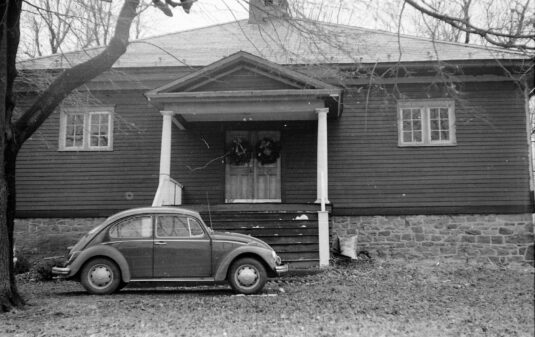 The reader, Ellen McCullough, wrote that the photograph was taken in 1974. The old schoolhouse had two large rooms plus an outhouse. (Her father added plumbing and a bathroom. Her mother “found a few metal toys in the spooky, unfinished basement, secreted in the spaces between stones in the wall.”)
I got this email about the time that I published an article by Egbert T. Bush about another old-time local school called “Summit School,” so it seemed like a nice time to give the Kendall School its due, since Mr. Bush never got around to it.1
In the years following the Revolution, one-room schoolhouses were sprinkled throughout Hunterdon County. Oddly enough, the village of Sergeantsville, which was an established location at the intersection of two old roads, did not have such a school for its residents. Instead, children living in or near the village attended the Green Sergeant School, located somewhat east of the Covered Bridge, also known as the Gen. John T. Sergeant School. That schoolhouse, located at the intersection of Reading Road with the Sergeantsville-Rosemont Road, was in operation since at least 1830 when the property owner, Green Sergeant, conveyed the small lot to the school trustees. (Today the building is so well-screened by shrubbery that a photograph is not possible.)
It was quite a walk from the village to the schoolhouse, and the hardship did not stop there. At the school itself, the practice was for older students to sit on hard benches along the walls, and the younger students to sit closer to the wood-burning stove in the center of the room.
The reader, Ellen McCullough, wrote that the photograph was taken in 1974. The old schoolhouse had two large rooms plus an outhouse. (Her father added plumbing and a bathroom. Her mother “found a few metal toys in the spooky, unfinished basement, secreted in the spaces between stones in the wall.”)
I got this email about the time that I published an article by Egbert T. Bush about another old-time local school called “Summit School,” so it seemed like a nice time to give the Kendall School its due, since Mr. Bush never got around to it.1
In the years following the Revolution, one-room schoolhouses were sprinkled throughout Hunterdon County. Oddly enough, the village of Sergeantsville, which was an established location at the intersection of two old roads, did not have such a school for its residents. Instead, children living in or near the village attended the Green Sergeant School, located somewhat east of the Covered Bridge, also known as the Gen. John T. Sergeant School. That schoolhouse, located at the intersection of Reading Road with the Sergeantsville-Rosemont Road, was in operation since at least 1830 when the property owner, Green Sergeant, conveyed the small lot to the school trustees. (Today the building is so well-screened by shrubbery that a photograph is not possible.)
It was quite a walk from the village to the schoolhouse, and the hardship did not stop there. At the school itself, the practice was for older students to sit on hard benches along the walls, and the younger students to sit closer to the wood-burning stove in the center of the room.
 In 1870, School Superintendent Cornelius Conkling issued his report on the county school districts, including Sergeant’s School. He wrote that there was no written history of this school. “Impossible to furnish any intelligent account of this district,” he wrote. The school district in 1873 when the Beers Atlas was published was District No.95. The Green Sergeant schoolhouse was located right in the geographic middle of the district. Trustees at the time were Joseph Williamson, Henry R. Manness, and Hiram Johnson. The teacher was Jonathan M. Hoppock.2
This first schoolhouse had become inadequate by 1870. But it was not until April 1872 that voters living in the school district No. 95 voted to spend some money on a new schoolhouse. One of the local newspapers (probably the Lambertville Beacon or the Hunterdon Democrat), announced that the voters wanted to build a new schoolhouse to replace the old octagonal building that has so long served as the “temple of knowledge” for the District. They ended up enlarging the old one at the cost of $300.
In 1870, School Superintendent Cornelius Conkling issued his report on the county school districts, including Sergeant’s School. He wrote that there was no written history of this school. “Impossible to furnish any intelligent account of this district,” he wrote. The school district in 1873 when the Beers Atlas was published was District No.95. The Green Sergeant schoolhouse was located right in the geographic middle of the district. Trustees at the time were Joseph Williamson, Henry R. Manness, and Hiram Johnson. The teacher was Jonathan M. Hoppock.2
This first schoolhouse had become inadequate by 1870. But it was not until April 1872 that voters living in the school district No. 95 voted to spend some money on a new schoolhouse. One of the local newspapers (probably the Lambertville Beacon or the Hunterdon Democrat), announced that the voters wanted to build a new schoolhouse to replace the old octagonal building that has so long served as the “temple of knowledge” for the District. They ended up enlarging the old one at the cost of $300.
A Sad Accident
In 1875, the Hunterdon Co. Democrat reported on the death of two men who “had been found dead in the schoolhouse situated near the village.” They were Joseph Sherman and Izer Rake. They had stopped there during a rainy night after an evening of drinking in the Sergeantsville “saloon” (today the Township Hall). They lit the school’s coal stove and lay down on the benches, never to rise up again. The article noted that Sherman and Rake lived “in the vicinity of Locktown.” If so, then the Green Sergeant schoolhouse was not on their way home. As it turns out, the schoolhouse they stopped at was identified in the obituary published for them in the Hunterdon Republican, which stated that the pair stopped at “Hoppock’s School House.” That schoolhouse was located well to the north, on Locktown-Sergeantsville Road not far from Plum Brook, in District No. 91. In early 1881, Henry H. Fisher, a local real estate magnate, died suddenly at the age of 80. The Gazette reported that he was “hale & hearty” one moment, walked down the stairs and dropped dead.3 It was so sudden that he had not gotten around to signing his will. The heirs agreed, on March 28, 1882, to convey two lots to his son, George H. Fisher, one of them being 0.85 acres bordering the great road from Sergeantsville to Stockton (today’s Route 523), and the other of 0.26 acres, also bordering the road from Sergeantsville to Stockton.4George H. Fisher
George Henry Fisher (1842-1925), a harness maker, was fairly prominent in the Sergeantsville area. In 1885 he was appointed postmaster of Sergeantsville, although he resigned in 1887. I thought perhaps he had military experience in the Civil War, as he was one of the reliable people to decorate graves in the Sergeantsville vicinity on Memorial Day, but there is no indication that he served. Perhaps he had lost some good friends. Once the Civil War had ended, George married Martha VanMarter (1846-1928) of Ringoes on Nov. 1, 1865, and the couple had six children. They set up housekeeping in Delaware Township and Fisher opened his harness shop, probably on property owned by his father. The Fisher’s house was located just south of the Fisher harness shop at the southeast corner of the main intersection of Sergeantsville. It was later moved further south where it was renovated by the Flemington National Bank and has since been re-renovated as a private residence. In 1885, George and Martha had a late birth, their youngest child David. Perhaps that is what inspired the Fishers to convey a property to the Sergeantsville School Trustees, on which to build a new schoolhouse. On July 4th 1889, George and Martha Fisher conveyed to the Trustees of School District No. 109 (George Boyd, George W. Bowne and George R. Hann) for $150, a one-acre lot for the schoolhouse.5 Note that the old district No. 95 had been changed to District No. 109. It did not take long to put up a new schoolhouse—school opened there the following September. We know this from Anna Lawshe Dilts, who wrote that she herself began teaching there in September 1889. Anna (1864-1949) was the daughter of John Carr Dilts and Hannah Vansyckel Lawshe. In 1895, Anna married Joseph Decker Wilson (1867-1961) and had one child, Emmert Rynier Wilson (1896-1976), who would establish a hatchery in Rosemont and in 1945 get elected to the State Assembly. Hon. Emmert Wilson was a fifth cousin once removed from Delaware Twp. historian, Clinton B. Wilson (1908-1985). Oddly enough, they were not related through the Wilson families. (I am publishing a Wilson Tree today that features some Wilsons who lived in and near Delaware Township, including Clint Wilson’s family. But Emmert Wilson is not included as he belongs on a completely separate tree. Instead of common Wilson ancestors, Emmert and Clint were descendants of Johannes/Jacob Moore and Apolonia Moret, German immigrants of the early 18th century.)6 In his article, “History of Kendell School in Sergeantsville,” Clint Wilson wrote that people usually gave 1890 as the year the school opened, but that was a misunderstanding based on the date of the deed, rather than commencement of classes. This is odd, since there is no question but that the deed was signed on July 4, 1889. It was not recorded, however, until Nov. 25, 1889—still not up to 1890.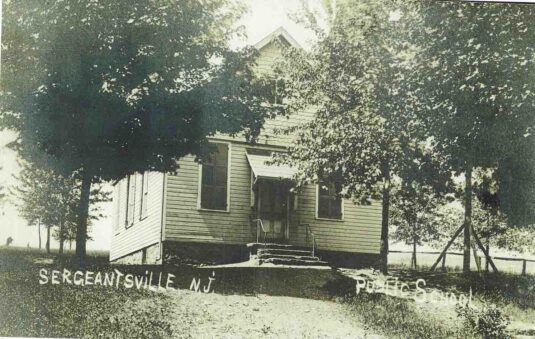 The lot sold by George & Martha Fisher bordered the public road from Sergeantsville to Flemington, a lot of Asher Reading’s and Fisher’s remaining land. And it was “with the understanding that “a good and substantial fence shall be kept along the remaining land of said Fisher, as well as one half the fence along the land now owned by Asher Reading, and for the enclosure of the lot to be kept in repair continuously without any cost or expense to Fisher or Reading.” It seems that Fisher and Reading did not want children in recess to be slipping over onto their properties. Above is a view of the new schoolhouse.
The lot sold by George & Martha Fisher bordered the public road from Sergeantsville to Flemington, a lot of Asher Reading’s and Fisher’s remaining land. And it was “with the understanding that “a good and substantial fence shall be kept along the remaining land of said Fisher, as well as one half the fence along the land now owned by Asher Reading, and for the enclosure of the lot to be kept in repair continuously without any cost or expense to Fisher or Reading.” It seems that Fisher and Reading did not want children in recess to be slipping over onto their properties. Above is a view of the new schoolhouse.
From One Room to Two Rooms
In 1913, the Board of Education decided to enlarge the building by adding another room and making it the only two-room schoolhouse in the Township. The work was done by Hiram D. Hoppock for $2,250. Mr. Hoppock was the father of Dora Hoppock Holsapple, who taught at the school for almost three decades. During the construction period, Catherine Porte taught grades 1 through 4 and Mabel von Braun taught 5 through 8. While the school was being enlarged, classes were held in Mechanics’ Hall, just down the road.7 Conditions were less than ideal in Military or Mechanics’ Hall, as it was also known; they used the large room on the second floor with a green curtain to separate the two groups. With only one stove to heat the whole room, it was a chilly winter for everyone. So, a better alternative was found—the building at the main intersection of Sergeantsville, next to Clint Wilson’s store. Wilson wrote:Sometime I hope to find out the facts about school once being held in the building next to my former store, the building then being known as Fisher’s Hall which is now [1957] the Town Pump. A long time ago, someone showed me a photo of pupils standing in front of this building.And here is the photo:
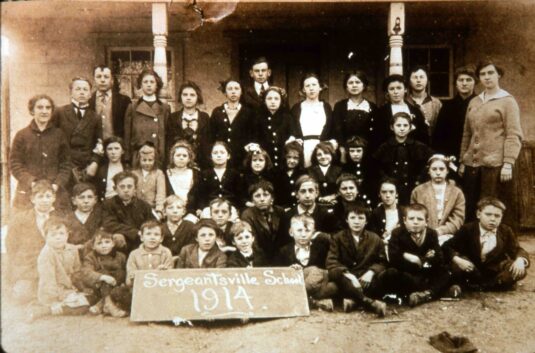 While the school building was being enlarged, the playground was too, by purchasing a small amount of land from neighbor Kensyl Reading.
Once the construction was finished, there was some celebrating to do. Everyone involved in the construction along with all the students and their teachers turned out for a photograph.
While the school building was being enlarged, the playground was too, by purchasing a small amount of land from neighbor Kensyl Reading.
Once the construction was finished, there was some celebrating to do. Everyone involved in the construction along with all the students and their teachers turned out for a photograph.
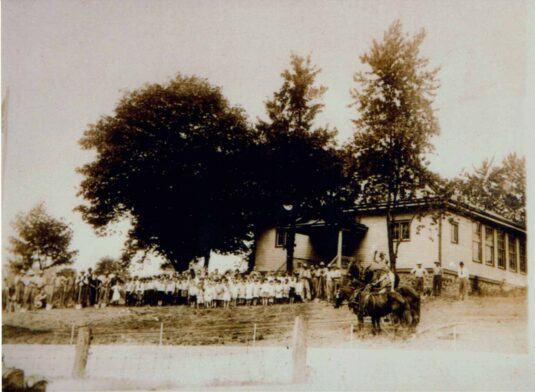 After being enlarged, the school was renamed the Kendall School after Calvin Noyes Kendall (1858-1921), the highly regarded State Commissioner of Education. This contradicted the long-held practice of naming the one-room schools after the neighborhood they were located in or the person who owned the property they were sitting on.
After being enlarged, the school was renamed the Kendall School after Calvin Noyes Kendall (1858-1921), the highly regarded State Commissioner of Education. This contradicted the long-held practice of naming the one-room schools after the neighborhood they were located in or the person who owned the property they were sitting on.
Newton V. Myers
 The system of dividing pupils by primary and secondary levels continued, and the teacher of the upper level was also the principle. Probably one of the best-known teachers at this school was Newton V. Myers. Bill Emery recalled that Myers was a very strict teacher. But he must have been something of a character, as we can see from this wonderful photograph of him sitting in the school yard.8 Notice the complete absence of grass.
Newton V. Myers (1879-1945) probably began teaching the boys’ classes there around 1910, when he was 30, not long after marrying his wife Lillian Mount Johnson (1886-1957) on June 30, 1909. She was the daughter of Jeremiah E. Johnson & Maude W. Mount. Newton Myers was the son of Israel H. Myers and Eliza E. Gary of Franklin Twp. where he first began teaching school. He taught school for 39 years (up to 1950).
At some time, he and wife Lillian were jointly given the job of postmaster of Sergeantsville. Lillian was one of the first women in this area to vote, in 1922. Clint Wilson also taught at the school after his eleven years at the Sand Brook School. Erva Cline was a board member at that time.
Here is a photograph of the second graders on a breezy day in 1937. Wish I could add names, but I cannot.
The system of dividing pupils by primary and secondary levels continued, and the teacher of the upper level was also the principle. Probably one of the best-known teachers at this school was Newton V. Myers. Bill Emery recalled that Myers was a very strict teacher. But he must have been something of a character, as we can see from this wonderful photograph of him sitting in the school yard.8 Notice the complete absence of grass.
Newton V. Myers (1879-1945) probably began teaching the boys’ classes there around 1910, when he was 30, not long after marrying his wife Lillian Mount Johnson (1886-1957) on June 30, 1909. She was the daughter of Jeremiah E. Johnson & Maude W. Mount. Newton Myers was the son of Israel H. Myers and Eliza E. Gary of Franklin Twp. where he first began teaching school. He taught school for 39 years (up to 1950).
At some time, he and wife Lillian were jointly given the job of postmaster of Sergeantsville. Lillian was one of the first women in this area to vote, in 1922. Clint Wilson also taught at the school after his eleven years at the Sand Brook School. Erva Cline was a board member at that time.
Here is a photograph of the second graders on a breezy day in 1937. Wish I could add names, but I cannot.
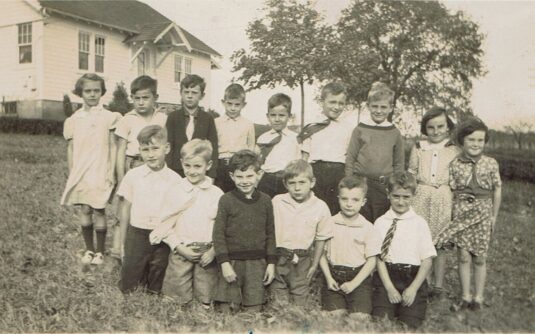
The School’s Last Days
The first Kendall School reunion was held in 1948, with over 200 students attending and 7 former teachers. That year there were only four schoolhouses in Delaware Township, Kendal, Vandolah, the old Green Sergeant’s school and the Locktown School. They all closed in 1950 when the new consolidated schoolhouse opened in Sergeantsville. On September 14, 1951, the school property was sold at auction for $7,400. But, as happened before, administrators had to find somewhere to keep the students while the new school was under construction. Sure enough, Kendall was reopened in 1952 to take the overflow from the new consolidated school, finally closing permanently in 1954. For a time, it was used by Anthony Suozzo, who ran the general store in Stockton, to store antiques and hold occasional auctions. Today the building is still a private residence, graced by a cupola which contained the school bell. Clint Wilson, who taught school there for a few years, wrote in his history of Kendall School:“As of this writing, the cupola is still on the building. This contained the school bell that once rang each school day at 9 a.m. calling the school in session, again at the end of the noon hour, and ringing to end a play period in the morning and afternoon known as recess.”That sort of amenity is no longer needed for today’s Delaware Township school.
Footnotes:
- I did publish an article that Mr. Bush wrote about Sergeantsville called “Sergeantsville, A Town That Outlived Its Original Name,” but the article never mentioned the Kendall School. Previous histories of the schoolhouse were written by Ronald Goeke & Maura Carr for the annual Thanksgiving in the Country Tour, and by Clinton B. Wilson, as part of his regular column in the Lambertville Beacon. ↩
- His local history articles may be found on this website. On the home page, right-hand column, scroll down to “Historians Revisited.” ↩
- Hunterdon Gazette, Feb. 22, 1881. ↩
- H.C. Deed Book 198 p.56. ↩
- H.C. Deed Book 225 p.41. ↩
- The Moore Family Tree was published some time ago, and is due for updating. However, Emmert Wilson does not appear on it because he was the grandson of Rachel Lawshe Moore, and my trees do not include grandchildren of daughters. ↩
- For some background on Military Hall, see “A Sergeantsville History.” ↩
- This and the other photographs shown here of the school and its students were shared with me by Paul Kurzenberger from his extensive collection. ↩
Ron
July 2, 2021 @ 12:29 pm
This is how most of the Greatest Generation was educated. Has education really progressed, or just become more expensive and impersonal?
Marfy Goodspeed
July 2, 2021 @ 12:54 pm
After publishing, I noticed that there were only three girls in that photo from 1937. Wonder what the reason was for that.
John R Sloan
July 2, 2021 @ 2:23 pm
Marfy – As always, thank you for the trip down memory lane which your Goodspeed Histories provide. This installment was especially poignant to me, as I was in that group of students who spent class time there while the new Delaware Township School was being finished. With that said it also puts me in the first graduating class of eighth-graders to graduate from the new consolidated school.
Regards, John Sloan
Joyce Kintzel
July 3, 2021 @ 12:20 pm
Thank you so much for this posting. What memories it brought back to me. I attended Kendall in the 1940’s from Kindergarten until 7th grad and Dora Hoppock Holsapple(the dearest soul) was my first teacher. 7th and 8th we were transferred to the Delaware Township consolidated school. I never enjoyed the luxury of plumbing. Girls and boys could not go out at the same time to use the outhouse and no hand washing, even for lunch, which we kept on shelves behind the piano. I broke many thermos inserts banging my metal lunch box over the heads of boys that teased me, much to my mother’s dismay when she had to buy replacements. We had one monkey bar for exercise and for play we had to use our imagination. We did have an indoor furnace in the basement thank goodness. We survived and thrived.
Stuart Wisse
July 3, 2021 @ 6:44 pm
Some years ago I compiled written and oral histories of daily one room school life in Delaware Township. The project was completed under the auspices of The Delaware Township Historical Society. About a dozen now passed citizens recorded their accounts live on tape and written transcripts. Priceless stories from Tom Lambert, Henry and Harriet Fisher, Wesley Bodine, Milt Smith, Edith Wilson, Louana Chamberlin Burenga, Bud Kusant, Joe Maresca and others live on.
Kendall School accounts of teachers Newton Myers, Clint Wilson, Dora Hoppock were all included in the project. Mr Myers was well known for his strict discipline and mathematical genius in the esteem of seventh graders. Mr Wilson would drive his car from his store at the blinker light to Kendall so he could pick up students who may not attend. Ms. Hoppock brought her piano with her from each school she worked in.
Students had chores as hauling drinking water buckets, and lighting the stove. Boys could bring their rifles to school during season to enable them to hunt on the way home.
Early school board members stocked the paper and books as well as kept the coal stoves going over the week end.
It is interesting to note that three of the contributors, Messrs. Lambert , Smith and Fisher later became school board members in town.
Their accounts wove together home, community and school life in our township.
Marfy Goodspeed
July 3, 2021 @ 7:17 pm
Thank you Stuart. I am so glad you took the trouble to record the experiences of these Township Elders.
Marfy Goodspeed
July 10, 2021 @ 7:45 am
I received this note from Bob Hornby that should be shared:
I believe you will find that the hatchery in Rosemont was established by Joseph Wilson, not Emmert Wilson. The hatchery was located on the Wilson Farm,, next to The Academy, about where Wilson Drive is now located, behind the big yellow house that looks down over the village. Joseph discovered that day old chicks could be shipped to as far away as Chicago and Buffalo without needing food or water : Hence, Stockton became a dispatch point for the baby chick industry. Edith Wilson Swain McCloughan, (recently deceased , 8/29/2020) was Emmert’s daughter and Joseph’s grand daughter and my good friend. Edie’s mother, Kathryn Porte Wilson also taught in the Sergeantsville School.
In a second email, he added that the hatchery was in Stockton, not Rosemont.
The hatchery I was thinking of was the one in Rosemont on what is known as the Cane Farm. I’ll have to double check that history.